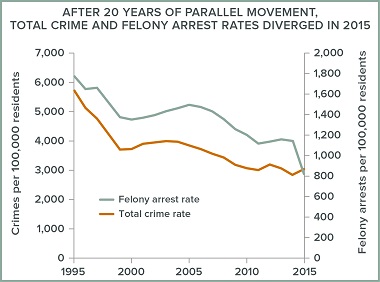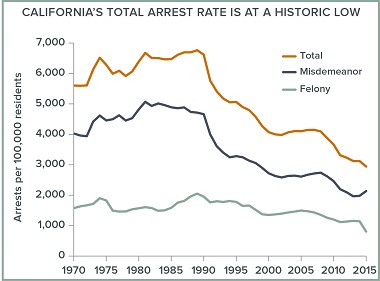
Recently released arrest and crime data from the California Attorney General’s Office reveal some noticeable recent changes. Until last year, California’s felony arrest rate trend had closely mirrored the state’s crime rate trend for 20 years. We would expect the two trends to move in similar ways, since most of the crimes reported and used to calculate the crime rate are felonies. But the trends diverged in 2015 after passage of Proposition 47, which reclassified a number of drug and property crimes from felonies to misdemeanors. The felony arrest rate dropped dramatically in 2015, by 30%, while crime rates went up—the violent crime rate rose by 8.4% and the property crime rate by 6.6%. The drop in felony arrests was partly offset by a very noticeable increase in misdemeanor arrests. Still, the total number of arrests dropped by almost 52,000.
California’s total arrest rate—which has been declining over the past two decades—is now at a historic low of 2,944 per 100,000 residents; this is less than half the peak rate of 6,765 reached in 1989. What is arguably more noteworthy is the even greater drop in the felony arrest rate, which, at 806 per 100,000 residents, is about a third of the 1989 peak rate of 2,052. The 30% drop in the felony arrest rate in just one year, 2014 to 2015, accounts for more than a quarter of the peak-to-bottom decline. Misdemeanor arrests, by contrast, increased from 1,979 to 2,138, or 8%.
 The data strongly indicate that Proposition 47 is a major factor in these changes. First, monthly arrest data show abrupt changes in drug and property arrests in November 2014, the month Proposition 47 went into effect. Second, the drop in felony arrests was almost exclusively for drug and property offenses, while the increase in misdemeanor arrests was almost entirely for drug and property offenses. Arrests for motor vehicle theft, which continues to be a felony after Proposition 47, is the only area of increase. Possibly in response to the 13% increase in auto thefts in 2015, motor vehicle theft arrests went up by 26%.
The data strongly indicate that Proposition 47 is a major factor in these changes. First, monthly arrest data show abrupt changes in drug and property arrests in November 2014, the month Proposition 47 went into effect. Second, the drop in felony arrests was almost exclusively for drug and property offenses, while the increase in misdemeanor arrests was almost entirely for drug and property offenses. Arrests for motor vehicle theft, which continues to be a felony after Proposition 47, is the only area of increase. Possibly in response to the 13% increase in auto thefts in 2015, motor vehicle theft arrests went up by 26%.
Although the total number of property crime arrests dropped, the decrease in arrests for drug offenses was more significant. Felony drug arrests declined by about 92,000, while misdemeanor drug arrests went up by more than 70,000. The net drop of about 22,000 drug arrests accounts for more than 40% of the total decline.
The new data raise many questions, including whether the recent changes to our criminal justice system are affecting public safety. Also, does the decline in drug arrests mean that drug use has declined or that fewer offenders with substance abuse problems are receiving necessary and effective treatment? Future research needs to address the role of reforms like Proposition 47 on crime, offenders, law enforcement, and counties’ ability to provide necessary treatment and programming.



